#goinggreenish
Explore tagged Tumblr posts
Text


Being an eco-friendly small pet owner 🐭
In April, Tom and I finally got our first pets together - two little mice! Having grown up with hamsters, I was painfully aware of how plastic-heavy small animals are. Their food, treats and bedding are all stored in plastic bags and their cages and toys are often ladened with plastic.
We were desperate to have life other than houseplants to look after, and we had fallen in love with the idea of getting mice. We were also desperate to not break the planet by getting them, however.
So! Here I am to share with you how our eco-friendly mice were brought about. A lot of this can be applied to rats, hamsters and gerbils etc. but bear in mind the specific care points are mouse-centric.
Before going into any details, I just want to disclaim that I was crushing on these mice hard, months before they were even born. I budgeted for them three months ahead and chipped away at buying their things over the course of those three months.
My mentality is to buy secondhand if I can, and if I can't then to buy high quality (and often therefore a bit pricey). This is manageable for me, but only because I'm an organisation gremlin and plan my budgets to the extreme.
🏠Starting with the cage:

This cage is the Ferplast Cage for Hamsters and Mice KARAT 60. The key thing here for me was that it's made of glass and metal, with minimal plastic - only the clips and wheel are made of plastic. Unfortunately for mice, they need a solid wheel which means we couldn't get a metal one. For mice, they need good ventilation as they're prone to respiratory diseases. They also need a deep base to the cage so they can exhibit their natural digging behaviour. The bar spacing of this cage is mice appropriate (0.6 mm or less) as mice are small! They can squeeze between the bars of some hamster cages.
Food bowls! Made of ceramic, one for grains, one for fruit and veg. Shallow enough that they can perch on them (often in them) to nom.
Wooden house and log. Instead of a plastic house, you can get lovely wooden ones that double up as good chewing posts for them as they get older. Plastic isn't the best thing for them to get their teeth onto.
You can't really see it in this photo, but the water bottle I have for them is made of glass instead of plastic. Always check the labels at the shop to make sure anything you're buying is suitable for the critter you're getting!
Edit: It's been brought to my attention that the scale of this cage isn't necessarily obvious from the photo! In terms of gallons, the glass tank is around 12 gallons and the cage area is a further 17 gallons, bringing the total volume of the whole area up to about 29 gallons (these are from my measurements, from the measurements on the product page, it comes out more around 27 gallons. Mine were a bit rough so maybe trust this number more!). For our two mice, this is an appropriate amount of space.
🛏️Now onto bedding:
Mice need materials they can burrow into, but also need a substrate at the very base of the cage to absorb their urine. If you're going a plastic route, this normally involves cat litter at the base and a mix of paper shredding and tissue shredding (if you get sawdust/wood chip, you have to be very careful with what wood it is from, as some trees irritate their respiratory systems)
My plastic-free suggestion depends on you already getting your loo roll and kitchen roll from a plastic-free company (like Bumboo or Who Gives a Crap).
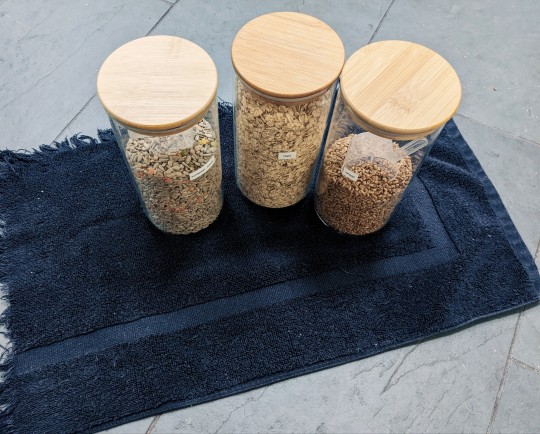
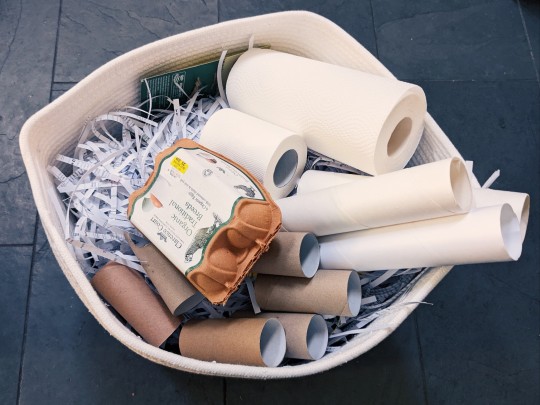
Substrate: As you can see here, the substrate we use is a (slightly mangled from the washing machine) bath mat. It's 100% cotton and every fortnight when we clean them out, we shake it out in the garden and pop it in the washing machine. We have two that we cycle between so the girls never go without. Be careful with what material you buy - 100% cotton is fine, but if it's a blend with a synthetic fibre it should be avoided.
Burrowing materials: Why on earth would you buy paper and tissue pre-shredded in a big plastic bag when you could just...shred paper...and tissue...at home? I got myself a cheap shredder and have one of the technicians at work hoarding scrap paper for me that would otherwise go in the recycling bin, so I'm re-using stuff that would get junked. After its use here, it can then go in our home recycling as our council accepts shredding in mainstream recycling. Whenever we clean the girls out, we add in some loo roll and kitchen roll that we tear up into strips by hand. We never use up all of our loo roll and kitchen roll from each Bumboo order anyway, so it doesn't cost us any more than our standard subscription already. Plus, two mice really don't use up much!
Extra bits: Nutmeg and Honeysuckle are very happy burrowing, running in their wheel and Spidermanning it around the cage bars and the ceiling, but we do provide them with tubes to tunnel through and some DIY structures we've made for them to play with. These are just from our usual waste of loo roll and kitchen roll.
🍴Lastly, on to food:
Now, we love the girls and hope they life a very happy 2-years-life-expectancy, but mouse food from pet stores is honestly a rip-off. Looking at the ingredients and talking to the staff there, there was nothing we couldn't get from our local refill store and farmer's market.

The girls get sunflower seeds, oats and wheat in their grains bowl and a selection of seasonal fruit and veg in their other bowl. Every now and then they get treats of popcorn (plain), different seeds and nuts (not walnuts which are toxic) and even some suet and seed block from what I buy for the garden birds. Nutritionally, this is what they get from the mouse food in the store - the ingredients list is identical to what we give them, the store stuff is just all dehydrated instead.
They are very happy. Almost too much. One of them is weighing in at a whopping 27 g. We're trying our best, moving on...
My point being that it's easy to avoid the plastic if you have a good refill store near you. Ours is priced competitively to the local supermarkets, so this isn't actually an expensive venture at all. But if you're living somewhere like London and have a refill store near you, I know this price comparison is a distant fantasy with a lot of them. On the positive side, the sunflower seed and wheat jars in the photo above haven't been refilled since I filled them first three months ago. They really don't each much! (Apart from Honeysuckle. Twenty-seven grams).
Apart from some balls for them to run around in, and a little carry case for transport, these mice use absolutely zero plastic, a far cry from the plastic-hungry hamster care from my childhood.
In conclusion:
It takes:
planning
budgeting
sourcing of resources
certain habits to already be instilled
but it is possible.
Just because they're little and often seen as the "easy" pets, doesn't mean they shouldn't get just as much love and planning as you would put into getting a cat or dog. Owning any animal is a responsibility one should take seriously and I feel that rodents and fish get overlooked deeply (did you know that a goldfish on average should have a 20 gallon tank?).
Here's to giving all animals a good quality of life! 🐭
#goinggreenish#ecofriendly#microplastics#microfibres#environment#goinggreen#plasticfree#ecotips#sustainablelifestyle#sustainableliving#plasticfreeproducts#greenshopping#lifestyle#eco tips#eco friendly#green lifestyle#green shopping#plastic free products#sustainability#pets#pet supplies#little pets#mice#pet mice#pet mouse#eco pets#eco pet#eco friendly pet#plastic free pets#pet care
29 notes
·
View notes
Photo

I love 11x17 paper... Everyone wonders what to do with it when when you hand it out at meetings. 😂😂😂 (Office trolling, only printed 2, I hang them afterwards #goinggreenish) #airwatch #vmware #emm #mdm
0 notes
Photo

SQUEEE!!! @radpowerbikes #radrover #ebike arrived today!! Assembly time. #goinggreenish #pedalcommute http://ift.tt/2lad45j
0 notes
Text





To all the chocolate lovers out there struggling to find a bar that's not plastic wrapped but is available across supermarkets, I introduce you to Tony's Chocolonely 🙌 Not only is it delicious chocolate, it's fair trade AND plastic-free. On top of this, Tony's Chocolonely has dreams to end the slavery involved in the cocoa industry, and supporting them supports this dream 🍫
Currently, due to unequal divisions in the cocoa chain, many cocoa farmers live in poverty which leads to child labour and slavery on their farms. Tony's Chocolonely uses 5 sourcing principles to ensure that the farmers they source their cocoa beans from earn a liveable wage, helping to eradicate the necessity for child labour and slavery on their farms. This includes providing their farmers with an additional premium on top of the standard fair trade premium, enabling their farmers to earn a wage that covers the cost of living for their household and their farm running costs. Every farmer gets this premium for at least 5 years so they can make long-term investments and decisions with security. This is just a fraction of what they do though - head to their website to read more! 🚜
Alongside all of this, all their wrapping is recyclable - paper and foil - and 100% plastic-free. Talk about a total guilt-free chocolate bar! Good for your rubbish bins, good for the farmers and good for the ethos of the chocolate industry 🌱
I've yet to find a plastic-free substitute for fruitella or drumstick squashies, so the void in my stomach for them lives on. But it's great to know there's a chocolate that I don't have to worry about what to do with the wrapper once I've demolished it 👍 What are your favourite plastic-free subs for sweet treats?
#goinggreenish#shopping#ecofriendly#chocolate#ecochocolate#greenchocolate#plasticfreechocolate#tonyschocolonely#fairtrade#endslavery#cocoa#ecofriendlychocolate#sustainablefarming#sustainable#environment#goinggreen#plasticfree#zerowaste#ecotips#sustainablelifestyle#sustainableliving#goingzerowaste#plasticfreeproducts#greenshopping#ecoshopping#going green#plastic free#sustainable lifestyle#sustainable living#eco friendly
84 notes
·
View notes
Text










Tom and I now manage to do a huge amount of our shopping totally plastic-free. I’ll do other posts on the non-edible side of shopping in the future and have already started with some bathroom and kitchen posts, but today I’m here to talk about ✨ f o o d ✨. This post is going to focus on fresh produce 🥦
Our current situation:
Fresh produce: We live in a town which has a farmers market every Friday and Saturday with loads of different stalls to provide most of our needs. We can therefore find plastic-free fruit and veg 9/10 (some is still cling-wrapped, but if we hit up the different stalls there’s normally one that has a plastic-free option).
To be inclusive, I feel like I should make a note on meat here. I'm veggie and strongly believe that environmentally, everyone needs to chill out on their meat consumption. However, putting my personal views aside, I acknowledge that lots of people are still meat-eaters and I want to give eco-alternatives to them, too. If you are a meat-eater, then try sourcing your meat more responsibly from places such as The Ethical Butcher. As far as the animal agriculture industry can be "good", this is the "good" type of farming.
If we can’t find a plastic-free option? Green beans are an example of something that can be a bit hit-or-miss in the plastic department. Sometimes the stall has them in a big box to grab handfuls of, sometimes they only have them in plastic-wrapped trays. At this point, I personally choose to boycott the plastic version and find different green veg to substitute in if needed. Not always an option depending on what you’re trying to buy and what you need for your diet, but I do it as best I can for non-vital ingredients.
The unavoidables: There are still plenty of things that are plastic-wrapped and that I can't boycott. I eat a lot of peas and cheese as a vegetarian, to get my protein in. Peas are very seasonal, so I get frozen bags from the supermarket which is a plastic that isn’t recyclable, even through Terracycle. Cheese packaging is an issue normally as well, but thanks to a Terracycle drop-off nearby, I can at least recycle the plastic rather than throw it in the general waste.
Our previous situation:
When we lived in London, we didn’t have a farmers market nearby us to get our fruit and veg from. We ended up doing a bit of a combi job between the local greengrocer and the supermarket. There was a lot of plastic in our lives still then, but we could get major fruit and veg without the plastic this way. Some things were unavoidable and we still brought in more plastic than we could have, simply because we were earlier on in our plastic-free journey. We used some hacks to try to minimise the waste though.
Things you can start doing today:
These are hacks that have been spoken about a million times before, but here are some tips on what to do if you have no markets or are unable to access them for whatever reason.
1. Bring your own bags.
2. Buy the fruit and veg that isn’t in plastic whenever possible. Support your local greengrocer if you have one. Find substitutes for the ingredients that you can’t find plastic-free where possible.
3. Buy bigger bags of things you know you’ll use. Getting pasta? Grab the biggest bag they have. You use less plastic buying one 3kg bag than you do buying 6 x 500g bags. This obviously assumes you will be able to transport the bag and also store it at home. Not all supermarkets do large bags of less used staples, but rice, pasta and oats tend to be available in bigger batches.
4. Explore your options. Different supermarkets sell different sized bags of staples. Look around the shops near you.
5. Check the reduced section at the supermarket. These are items that will be going off soon according to their Best Buy dates. They will be disposed of in a huge food waste heap of plastic if they aren’t bought. A lot of things can survive a day or two or more past their Best Buy dates. For foods like meat, freeze whatever you won’t eat on the day you buy it and it should be fine.
6. Boycott what you can. Make substitutes where you can.
7. Buy glass, cardboard, paper or metal over plastic where you can.
8. If you’re veggie or vegan (or just cutting down on meat), avoid the ultra-processed stuff like Quorn etc. It’s not great for your health and it adds plastic. A lot of meat substitutes are soy based, which isn't planet friendly. Force yourself to think about what you’re cooking for yourself and see what alternatives you can do.
9. Frozen veg in plastic bags can be better than fresh veg in some situations. My example of peas from earlier is one. If I was to source fresh peas right now, they would likely be grown abroad with a large footprint behind them. Frozen peas I can buy in big bags and they’re British peas which were grown in the summer and frozen. In the summer, when local peas hit the market, I plan to bulk buy and freeze them myself, but in the meantime, this is the compromise.
10. Say no to the receipt whenever you can. The paper isn’t recyclable.
11. Buy bigger pots of things you know you’ll use before they go off. If you can’t find milk, yoghurts, cream and custard etc. in glass (very rare and often very expensive), then buy the biggest bottle or tub you think you’ll get through. Get one big tub of yoghurt and portion it out into smaller containers at home rather than a 6 pack of snap-pots. Get the big block of cheese.
12. See if you can re-use or up-cycle any of the plastic you do buy. Growing up, my sister was obsessed with coleslaw, and we had millions of little tubs lying around the house. My mum would use them to store dog treats in, little bits of electronics like spare fuses or small light bulbs, she’d use them to portion out treats to us in our school lunches, we used them as tubs for mixing paints in when getting artsy, she used them as starter pots for growing seeds etc. etc. There are lots of ideas out there if you look.
#goinggreenish#shopping#ecofriendly#sustainablefarming#sustainable#environment#goinggreen#plasticfree#zerowaste#ecotips#sustainablelifestyle#sustainableliving#goingzerowaste#plasticfreeproducts#greenshopping#ecoshopping#going green#plastic free#sustainable lifestyle#sustainable living#eco friendly#eco tips#zero waste#eco shopping#market#farmers market#fruit#cooking#vegetables#green shopping
15 notes
·
View notes
Text
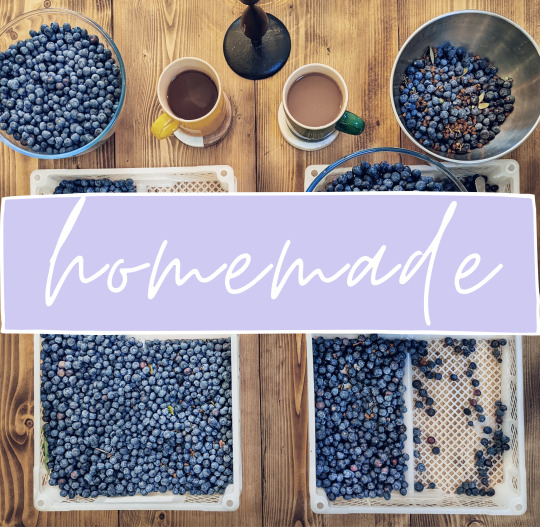
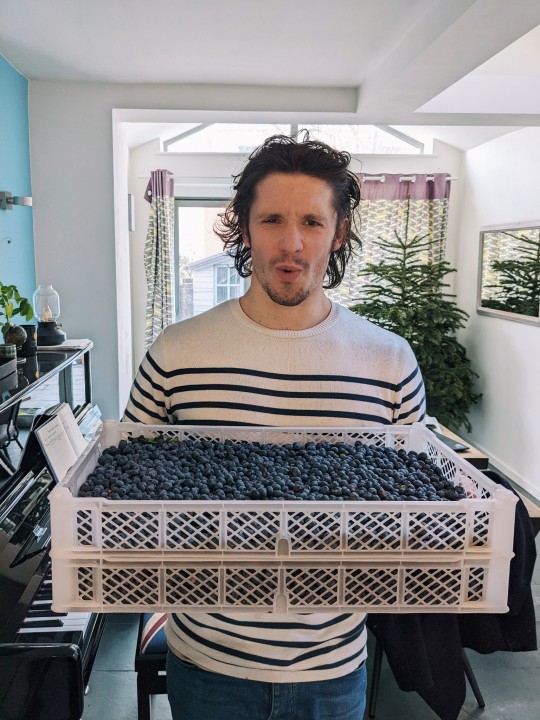
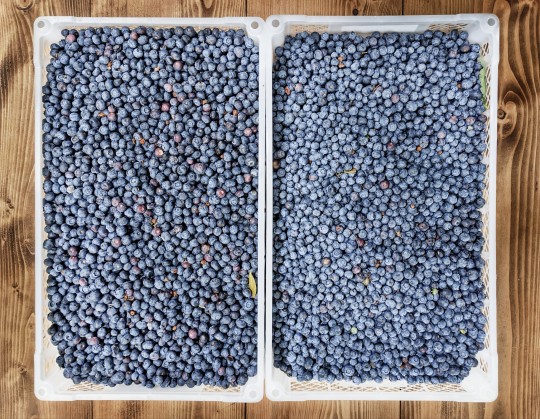

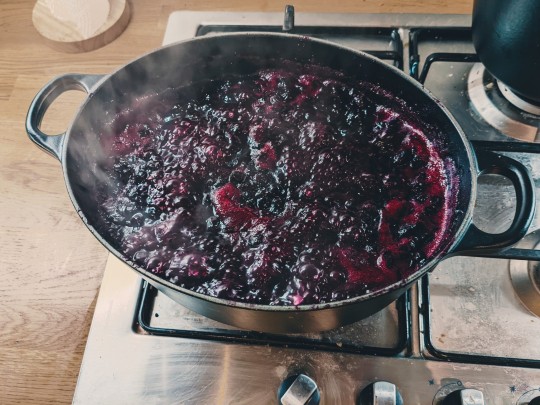
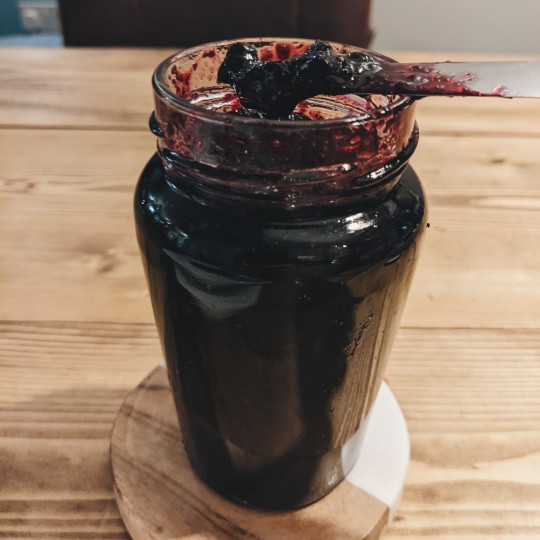
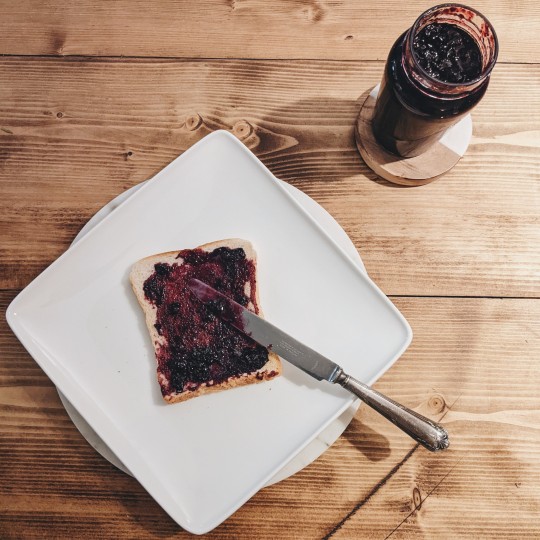
Today was a jam-making day 🫐 We have a local farmer's market every Friday and Saturday (more on that in a later post) that we get all our fresh produce from. This is one of the biggest ways we manage to cut plastic out of our shopping trolleys, and it's also a way to make some killer savings. Today, one stall was selling these massive 3.5 kg punnets of blueberries for £4 each. Tom's obsessed with blueberries, and we've made jam with them before, so we grabbed a couple of punnets and made our way home 🏃♀️🏃♂️💨💨
Jam's not necessarily the worst thing in the world to buy ready-made from the supermarket. The packaging is reusable and/or recyclable, but often it can be hard to find jams made in your country. Here in the UK, most of the major brands come from France. Unless they have a ticket on the Eurostar, that means they're either shipped or air-freighted over (we all know how bad planes are, but let's not forget how awful shipping is for emissions either) 🚢
Now, let's not pretend that these blueberries are grown on home soil. In January, they're most likely coming from somewhere south of the equator - carrying a larger carbon footprint than they would if they were hopping over from France. But we've made 10 jars of jam from one of these punnets and have frozen the contents of the second punnet for adding whole to porridge. That combined should last us most of this year. One journey with a large footprint to make jam in our own jars is better than 10 separate journeys for 10 separate jars of jam over the next 10 months. Given that if we wanted to buy whole blueberries, our options are getting smaller punnets on a weekly basis, in plastic, shipped every week from afar... or frozen blueberries in plastic bags, overall I'd say one big bulk shipment is the friendlier of the two.
Thinking through the maths and given the off-season nature of the blueberries, it's not the biggest footprint saver we could have. But by making our own jam we have made an improvement by:
a) using less sugar than a jar on the shelf would contain (healthier for us and the planet)
b) using a higher fruit content than the equivalent jam we'd buy (which has 50% fruit with the rest being made up of fruit concentrate)
c) reusing 10 jam jars instead of buying more glass in (it's very hard to know how much of the glass we buy in is virgin versus coming from a recycled background)
d) buying in bulk, limiting our carbon impact to the one journey rather than multiple ones
e) saving on the energy costs of the production line that manages all the labelling of the jars and the inks involved
And by using this bulk buy to freeze whole blueberries we have:
a) reduced the amount of plastic significantly (from the supermarkets, you usually get 250g or 500g punnets in plastic containers that aren't as re-usable as these big punnet trays)
b) reduced the shipping impact of getting smaller punnets more regularly
It just goes to show that with some items, it can ultimately not be all that much better for the environment to DIY it unless you're buying in big bulk batches! If we were making our own jam from the small punnets you can get off the shelf, that would be worse than buying a jar of jam.
How will we improve this next time? Bulk buy in the summer when the majority of the blueberries are British or from Northern Europe and have our jam-making escapades then. That version of this story will definitely carry a smaller carbon footprint than a supermarket shop.
For now, I share our imperfect journey of stumbling through all the factors to consider as we try to get that little bit greener.
PS. The punnets will be reused in the spring as starter trays for our veg garden 🌱 All the "bad" blueberries that we picked out, we put out in the garden for the birds to feast upon 🐦
#goinggreenish#eco friendy#going green#plastic free#zero waste#eco tips#sustainable lifestyle#sustainable living#going zero waste#plastic free products#green shopping#eco shopping#homemade#jam making#blueberry jam
9 notes
·
View notes
Text






There are lots of sodium bicarbonate hacks out there - this one I have deemed a success! ✅ It's all very well and good keeping jam jars to re-use, but sometimes when the labels come off, the sticker residue is left to remain forevermore.
So! To remove sticker residue off glass jars and bottles, simply mix some oil and sodium bicarbonate into a paste, smear it on and leave overnight. Wipe it off with a cloth the next day et voilà! ✨(Note, economically, it is better to use cheaper oil than pictured here. It will also keep the oil fanatics in the family happy. Tom was not well pleased that I was using his fancy oil for cleaning purposes!)
I've had a hard miss with a sodium bicarbonate grout cleaner mix I tried, but this residue cleaner really works wonderfully. Some residues require a bit more elbow grease than others. As someone who is refusing to throw out any jam jars at the moment, this makes reusing them a lot nicer without constantly having my hair, lint, general fluff, dust and dirt getting stuck to the outside of them 🤸
#goinggreenish#lifestyle#ecofriendly#cleaning#ecocleaning#greencleaning#diycleaning#diyhome#jars#jamjars#ecofriendlycleaning#sustainablecleaning#sustainable#environment#goinggreen#plasticfree#zerowaste#ecotips#sustainablelifestyle#sustainableliving#goingzerowaste#plasticfreeproducts#greenshopping#ecoshopping#eco tips#sustainable lifestyle#sustainable living#zero waste#going green#eco friendly
5 notes
·
View notes
Text








What do all of these photos have in common?
They were all taken whilst on public transport of one kind or another. Bus, ferry, train - all methods of getting around that are better than flying or taking a personal car. 100 people on a train is 100 cars off the road for that journey.
Obviously, we also need to work on greenifying our public transport systems, but a shared journey is still better than getting in the car 🚄
If you can't avoid driving, then try to car-share as much as possible! More people in one vehicle means fewer vehicles overall. If everyone car shared with one other person going the same route, then just think about how much quicker your commutes would be as well 😉
I'm hoping that these snaps might help some people see that part of the beauty of travelling can be in the journey and not just in the destination 🌅
(That being said, the destinations of places you can get to by public transport can be pretty phenomenal as well. More on that in a later post 📷)
#goinggreenish#environment#sustainable living#sustainable lifestyle#eco friendly#going green#eco tips#climate change#travel#photography#naugty#trees and forests#public transport#lifestyle#green lifestyle#ecology#sunset#mountains#blue sky#countryside#commute#commuting#train#carbon footprint#eco living#travelling#wanderlust#eco travel#eco travelling
4 notes
·
View notes
Text










Trying to live more eco-aware is all about trying to find the fixes that work for your life and your situation. A lot of the time, it comes down to compromise, especially when it comes to food. You have to eat and not everyone’s options are the same due to various reasons (health, finances, location, religion). Please take my posts with the pinch of salt (pun intended) required, they’re suggestive, not prescriptive. I’m aware that even though I try to make them accessible to the most people possible, they aren’t! More on this on my About page if you’re interested.
With that being said, continuing on the ✨f o o d✨ post, I’m going to focus on non-perishables in this one 🍝
Our current situation:
Non-perishables: We are now in the fortunate position of having two refill stores in town. Both of these are stores, cafes and community hubs wrapped up into one building, doing outreach talks, classes and more. One is a Terracycle drop-off point which has been infinitely useful for things like cheese packaging. Pasta, sugar, rice, granola, grains, oils, spices, herbs, nuts, even chocolate and sweets (though none of my personal favourites, RIP drumstick squashies) - these are all the things we can get from the refill stores and have made the biggest impact on our plastic consumption. Please feel free to zoom in on the photos to see all the goods available.
We still use supermarkets for most jars and tins and we still tend to get flour from the supermarket too, as it comes in a paper bag.
You can see our containers in one of the photos - it’s important to note that we have built up this collection of aesthetically pleasing jars over the last two years. It is an expensive and totally unnecessary route to go. Any container will work, some of ours are just jam jars that we have re-used. You can use Tupperware tubs, paper bags, anything that will hold whatever food it is you’re putting into it. We are in the position where we could afford to chip away at something we wanted aesthetically over the course of two years, but if you aren’t in a position to make it “look pretty” then that’s okay. It is a personal choice that we were lucky to be able to make, not a necessity.
Crisps and sweets are some things that are hard to come by in plastic-free packaging, though some brands are up and coming. I personally boycott them both due to this.
Our previous situation:
The refill stores have only opened up in the last 6 months so we were only able to buy from the supermarkets up until then. We tried to bulk buy online in large bags as well which seemed better on the one hand, for using less plastic. On the other, the carbon footprint associated with the delivery and shipping and all made it a decision that felt like it made no big impact at all. I am still working through a bag of bulgar wheat that I bought over a year ago though, so maybe it wasn’t the worst call in the world.
Things you can start doing today:
I’m going to post these hacks again here for those who won’t have seen my post on perishable foods. These have been spoken about a million times before, but here are some tips on what to do if you have no markets and no refill stores or are unable to access them for whatever reason.
1. Bring your own bags.
2. Buy the fruit and veg that isn’t in plastic whenever possible. Support your local greengrocer if you have one. Find substitutes for the ingredients that you can’t find plastic-free where possible.
3. Buy bigger bags of things you know you’ll use. Getting pasta? Grab the biggest bag they have. You use less plastic buying one 3kg bag than you do buying 6 x 500g bags. This obviously assumes you will be able to transport the bag and also store it at home. Not all supermarkets do large bags of less used staples, but rice, pasta and oats tend to be available in bigger batches.
4. Explore your options. Different supermarkets sell different sized bags of staples. Look around the shops near you.
5. Check the reduced section at the supermarket. These are items that will be going off soon according to their Best Buy dates. They will be disposed of in a huge food waste heap of plastic if they aren’t bought. A lot of things can survive a day or two or more past their Best Buy dates. For foods like meat, freeze whatever you won’t eat on the day you buy it and it should be fine.
6. Boycott what you can. Make substitutes where you can.
7. Buy glass, cardboard, paper or metal over plastic where you can.
8. If you’re veggie or vegan (or just cutting down on meat), avoid the ultra-processed stuff like Quorn etc. It’s not great for your health and it adds plastic. A lot of meat substitutes are soy based, which isn't planet friendly. Force yourself to think about what you’re cooking for yourself and see what alternatives you can do.
9. Frozen veg in plastic bags can be better than fresh veg in some situations. My example of peas from earlier is one. If I was to source fresh peas right now, they would likely be grown abroad with a large footprint behind them. Frozen peas I can buy in big bags and they’re British peas which were grown in the summer and frozen. In the summer, when local peas hit the market, I plan to bulk buy and freeze them myself, but in the meantime, this is the compromise.
10. Say no to the receipt whenever you can. The paper isn’t recyclable.
11. Buy bigger pots of things you know you’ll use before they go off. If you can’t find milk, yoghurts, cream and custard etc. in glass (very rare and often very expensive), then buy the biggest bottle or tub you think you’ll get through. Get one big tub of yoghurt and portion it out into smaller containers at home rather than a 6 pack of snap-pots. Get the big block of cheese.
12. See if you can re-use or up-cycle any of the plastic you do buy. Growing up, my sister was obsessed with coleslaw, and we had millions of little tubs lying around the house. My mum would use them to store dog treats in, little bits of electronics like spare fuses or small light bulbs, she’d use them to portion out treats to us in our school lunches, we used them as tubs for mixing paints in when getting artsy, she used them as starter pots for growing seeds etc. etc. There are lots of ideas out there if you look.
#goinggreenish#shopping#ecofriendly#sustainablefarming#sustainable#sustainableliving#sustainable farming#sustainable living#environment#going green#goinggreen#plasticfree#zerowaste#ecotips#sustainablelifestyle#goingzerowaste#plasticfreeproducts#greenshopping#ecoshopping#plastic free#sustainable lifestyle#eco friendly#eco tis#zero waste#eco shopping#market#farmers market#cooking#green shopping#refill
3 notes
·
View notes
Text
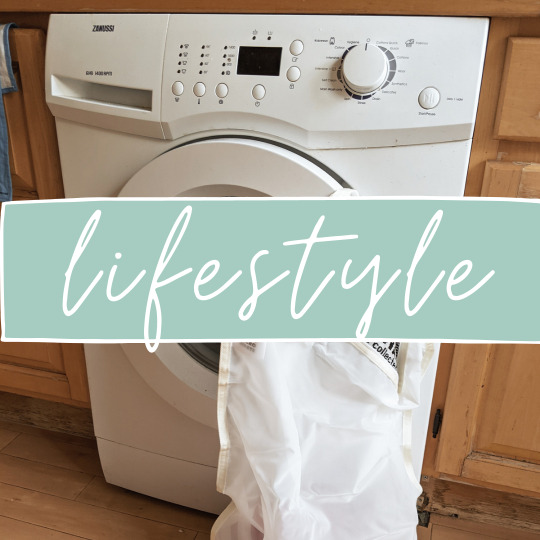

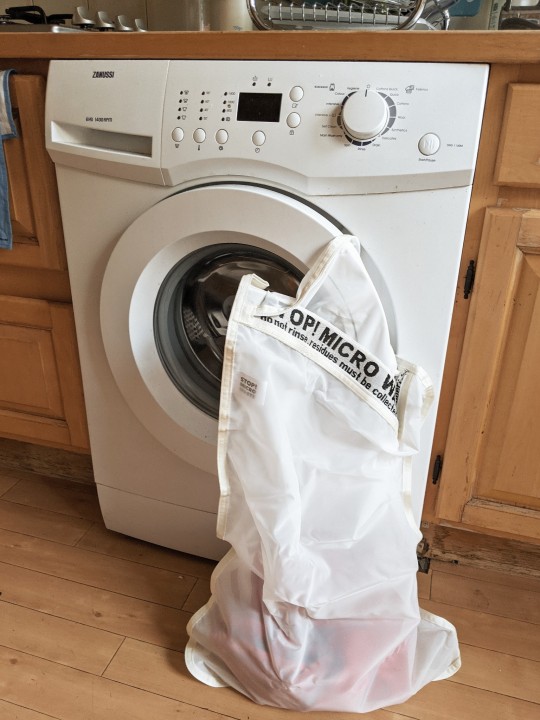
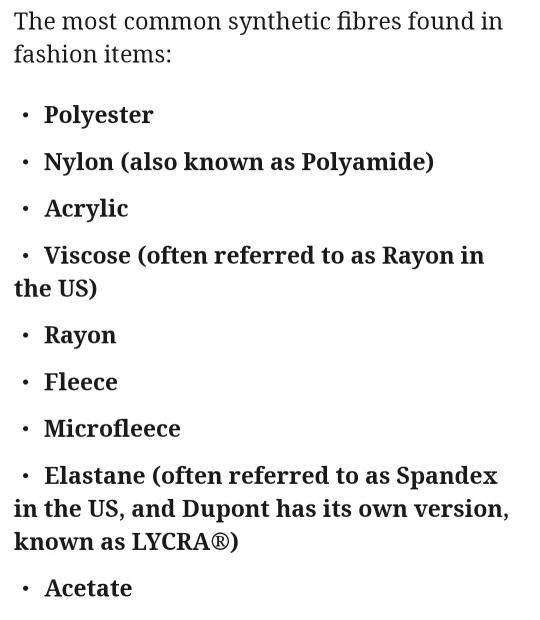
So I'm sure most of you have heard about how microplastics are a huge issue, but new focus is honing in on the microplastics that are created from our laundry - microfibres 👕 These are carried into our water systems every time we wash clothes that contain any synthetic material 👖(Note: Natural fabrics like cotton also make microfibres but these biodegrade far faster than the microfibres created from synthetic materials. The jury's still out on some materials like bamboo). Enter GuppyFriend 🤸
GuppyFriend is a big bag that you put your synthetics in when you do the laundry. The microplastics get trapped inside the bag, which you then remove when they build up. Once your bag gets too tired to keep going, you remove the zip and put the bag in the mainstream recycling (you will still need to buy a replacement, and at £25 a pop, they're a bit of a luxury buy, though the bag is huge!)♻️ I've put a screenshot from one information source in the fourth photo as to what count as environmentally harmful fabrics. Feel free to do your own research, but this is the guide I used when separating out the washes 🧺
If you do get one, read the instructions carefully - you can't use washing detergents containing liquid plastics 🚫
Overall, a simple solution to a big problem that will have a big impact!🐙 Most of us are used to separating clothes based on colours, delicates or not, material etc. already, so one shift in consideration isn't energy exhaustive. Add it to your future to-buy list even if you can't make the investment just yet. These are tackling a real issue, and should definitely be kept in mind! 🦦
#goinggreenish#ecofriendly#laundry#ecolaundry#microplastics#microfibres#greenlaundry#environment#goinggreen#plasticfree#zerowaste#ecotips#sustainablelifestyle#sustainableliving#goingzerowaste#plasticfreeproducts#greenshopping#oceanfriendly#lifestyle#eco tips#eco friendly#green lifestyle#plastic fantastic#green shopping#plastic free products#sustainability#save the ocean#savetheocean
4 notes
·
View notes
Text






Dental care eco-swaps!
Toothbrushes
First and foremost, the easiest swap is to switch to a bamboo toothbrush. Biodegradable, plastic-free and made from a fast-growing plant that is widely being recognised as a sustainable material swap. Now the jury is still technically out on just how sustainable bamboo is (here's a fantastic article to read on this if you're interested), but overall it can be agreed that a plastic toothbrush shipped over from China is worse than a bamboo toothbrush which has a similar footprint due to China really being the only country properly exporting bamboo.
My ratings on these bamboo toothbrushes is 5/5. 🪥🪥🪥🪥🪥
Durability: they last as long as I would keep a plastic toothbrush going before throwing it away.
Bristles: super soft which is great for your teeth and gums. I was a medium-hard kind of gal with plastic toothbrushes, and the softness took a while to get used to sensation-wise. Now though, I hardly ever spit blood when brushing my teeth - something I had totally normalised when using even the "soft" bristle plastic toothbrushes!
Disposal: different bamboo toothbrushes have different abilities to biodegrade. The ones pictured here are 100% compostable, but some you have to remove the bristles off first before putting them in your compost waste.
General use: they don't taste or smell any different to plastic toothbrushes. They stain a little bit more easily with toothpaste etc, and if you don't keep them well-drained then they can get a bit black and mouldy at the tip of the handle. Overall, neither things I particularly mind in the face of all the benefits!
Toothpastes
Onto toothpaste next! I, unfortunately, have very crumbly teeth. I found out the hard way during lockdown #1 that if I stop using my prescribed mouthwash for more than a month, I start getting pits in my teeth that can degrade into cavities. For health reasons, I will never have a 100% plastic-free dental regime and it's important for that to be okay. This is a bit of a side note, but if you have a medical reason that means you can't boycott certain plastic products (think: medicines that come in plastic packaging, utensils, tools or aids that are made from plastic etc.) you shouldn't sacrifice your health or be made to feel like you should in order to be "greener".
This means that I also have had some issues with all the different plastic-free toothpastes. I haven't yet tried toothpaste tablets due to fear of needing fillings if they're less effective than pastes (the fear is very real), but I have tried both of the above.
1. Introducing Truthpaste. Truthpaste describe themselves as "Botanical natural toothpaste with certified organic ingredients. Zero waste, palm free & vegan. Supports gum health & suitable for sensitive teeth." They are definitely a flavoursome, plastic-free alternative to the ones you get on the supermarket shelves. I tried them for about a month and found that with my dental issues, my teeth became very sensitive and painful without some of the standard dental ingredients. Tom uses them now without issue - proof that the product is totally fine and dentally healthy if you have normal teeth!
2. The toothpaste that I've found is the best compromise for me is Colgate's Smile For Good toothpaste. The plastic is fully recyclable (made from HDPE plastic like milk cartons, so can be placed in the normal recycling stream) and the ingredients are 99.7% "natural". That 0.3% "synthetic" is what helps my teeth survive. It's not the mintiest flavour, so needs a good mouthwash/tablet if you're looking for odourless breath! 👄 (My take on "natural" versus "synthetic" is a whole different rant, if you're wondering over my use of speech marks. As a chemistry specialist, I disagree with ingredients being labelled as such, but I use the vocabulary here for accessibility). It's vegan-certified if you're interested in that kind of thing, but it is more expensive than a standard tube of toothpaste. The issues with using this toothpaste are clear, but I feel like it's a good middle ground considering my teeth don't allow much flexibility in this area.
In any case, these alternatives are something to sink your teeth into (😉) if you're looking to greenify your bathroom a bit!
#goinggreenish#bathroom#ecofriendly#dental#toothpaste#ecobeauty#ecofriendlybeauty#crueltyfree#ecofriendlytoothpaste#ecoteethcare#ecofriendlydental#greenbeauty#dentalproducts#greendental#greentoothpaste#sustainable#environment#goinggreen#plasticfree#zerowaste#ecotips#sustainablelifestyle#sustainableliving#goingzerowaste#greenshopping#ecoshopping#eco friendly#eco beauty#eco friendly beauty#haircare
2 notes
·
View notes
Text





Here to tell you about bumboo_uk, a loo-roll subscription service 🎍"A what?" I hear you ask! Perhaps you're unfamiliar with the term loo (toilet) or perhaps (like me) you never thought about getting loo roll delivered to your door. Enter Bumboo. 100% bamboo loo roll, ordered in batches of 48 subscribed to whatever frequency you require based on your household usage (my fiance and I have gone by their handy recommendations for a 1-2 person household of a delivery every 20 weeks) 🚽
Plastic-free, tree-free, extra-long triple-ply loo-roll, a tree planted for every box purchased AND hands down the best name for bog roll in the history of humankind. What's there not to love?
As an extra boon, if you're careful with the paper and iron it out, you have free wrapping paper! We've been with bumboo for over a year now and I haven't had to buy wrapping paper since 2020 💪
#goinggreenish#dirt#bumboo#environment#bathroom#eco bathroom#plastic free#sustainable living#going zero waste#sustainable lifestyle#going green#green living#recycling#zero waste#sustainable#eco tips
2 notes
·
View notes
Text

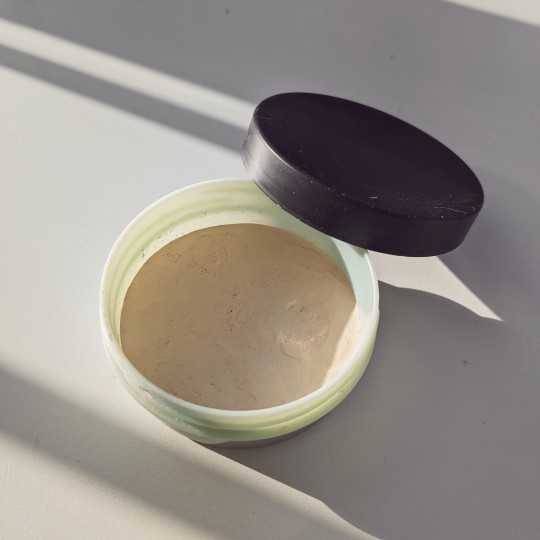

An old hack now but one that's still useful! Rationalising old make-up stores. About a year ago I found 4 old compact powders that I had stopped using because the palettes were worn through in the centre to where my brush barely picked them up. Enter my most recent Body Shop body butter empty pot and a spoon et voilà! A brand new compact 💄 Unfortunately, the old compact containers weren't recyclable and not really reusable for anything else either 😞 However, what would have once been thrown has been scavenged with all useful parts utilised. This pot is still ticking along, but I am now supplementing my compact powder choices with those from Zao makeup 👍I'll do a separate post on them, but 90% of my makeup comes from them these days. Remember that the most sustainable product is the one you don't buy - make full use of everything you have first 👐
#goinggreenish#ecofriendly#makeup#beauty#ecobeauty#diymakeup#diybeauty#ecomakeup#powder#compact#ecofriendlymakeup#sustainablebeauty#sustainablemakeup#environment#goinggreen#plasticfree#zerowaste#ecotips#sustainablelifestyle#sustainableliving#goingzerowaste#plasticfreeproducts#greenshopping#ecoshopping#plastic free#eco tips#zero waste#eco friendly#going green#sustainable beauty
1 note
·
View note
Text




Looking for an alternative to cling film? Try out beeswax wraps! 🐝
Admittedly, I likely wouldn't have tried these out if they hadn't been a gift. At the time, the only ones I was coming across were a bit spenny. The price has come down on them a lot now though, and they are definitely more attainable!
Usage: they aren't a perfect substitute for cling film, let's get that out there right now. I haven't managed to get the same "perfect seal" and I probably wouldn't trust them to keep things fresh for as long as cling film would. But they are totally moldable shape-wise which is useful. Make sure your hands are warm when wrapping them as it makes the cotton more malleable.
Reusable where cling film isn't, totally washable and refreshable.
I personally haven't used cling film to wrap anything in years now. If the beeswax wrap isn't the right option or my silicone caps don't fit, I use tin foil as I can keep the sheet and reuse it after, or at least recycle it once I'm done with it.
Durability: these can be rewaxed to extend their lifespan by buying wax bars (from a beeswax wrap company, not just any old wax bars) and grating it over the top before ironing it. Full methods can be found online, but this helps them last that little bit longer!
When the cotton is totally worn through and you can't revive your wrap any further, then you can cut them into strips and use them as natural fire-lighters 🔥 Most of them are compostable as well, meaning the end of their life is a more decomposable one than cling film.
Vegan? There are bee-free options, too!
There are also silicone covers (pictured) that stretch over bowls, jars, I even use them to stretch over onions and lemons that I've chopped in half (there are also silicone food huggers specifically for this). These are also washable and reusable, and you can buy them in different shapes to suit square and rectangular containers as well. This was where I started before being gifted the beeswax wraps. Obvious drawback here is that you can't wrap oddly shaped food in them (though silicone wraps exist as well). That means you need the containers going spare to store in the fridge - as someone who hates the taste that tupperware gives food, this means I have to use our crockery, something we don't have a large excess of! They keep food as fresh as cling film though, if you have the right sized lid then they form an air-tight seal against the container.
Of course there are also the options of storing things wrapped in tea towels, paper bags and the like. These options might not keep food fresh for very long, but if you're only putting something in the fridge overnight then they're better than getting the clingfilm out to play!
Leftover glass jars and bottles are always an option, as is tupperware and old takeaway containers that you've cleaned. Anything with a lid can be used, really, just make sure it's made of a material that is safe for food storage! Also be aware of what type of food you're storing. If you have something that's fairly acidic or alkaline, then you're probably best off storing it in chinaware or glass just to be on the safe side.
All in all, there is a wealth of options available to you if you are looking to move away from clingfilm - these are but a few! 👍🏽
#goinggreenish#kitchen#ecofriendly#eco friendly#sustainable#sustainability#sustainable living#sustainable lifestyle#environment#plastic free#plasticfree#zero waste#zerowaste#eco tips#ecotips#eco shopping#green shopping#beeswax#beeswax wraps#silicone wraps#food storage#eco kitchen#storage solutions
1 note
·
View note
Text


It's been a year since I made the switch to these products, bought from Plastic Freedom made by Flawless Vegan Beauty 🧖 They smell divine, plus I got gifted some lovely tissue paper! Before this, I was using Garnier's micellar water and Simple's toner. They worked fine for my skin, but the plastic waste was immense, alongside the cotton wool waste. Cotton wool is better than face wipes as they don't contain plastic fibres, but cotton as a plant is very water-intensive! Making the switch incurred a brief stage of rage from my skin, but after about a week it settled down and I've felt a lot better about my waste ever since. Throwing in the re-usable cotton pads and I haven't thrown anything but glass and metal away in my skincare routine for a year! 🤗
If you're shopping online, buying in bigger batches (of staple products you know you'll use) minimises the delivery carbon footprint and is a great idea if you have the storage and are buying non-perishables 🚛💨
It's also important to know a) what your local council will recycle and b) how good your country is generally at recycling certain products. The UK is pretty good with their glass recycling, so I feel comfortable with producing glass waste if I have to produce it at all. But if your recycling schemes aren't good and what you use is going to just sit in landfill either way, try to avoid products with small attachments that could end up in the food chain, and throw away lids and caps screwed on so they're less likely to escape!
Making changes isn't about being perfect, it's about doing the best we can in the systems we live in and trying to enact change to improve those systems. ♻️
#goinggreenish#beauty#eco friendly#going green#micellar water#best korean toner for sensitive skin#facial products#cosmetics#environment#plastic free#zero waste#eco tips#sustainability#sustainable lifestyle#sustainable living#going zero waste#plastic free beauty#plastic free products#beauty products#cleansing#plastic free cleaning#recycle#recycling
0 notes